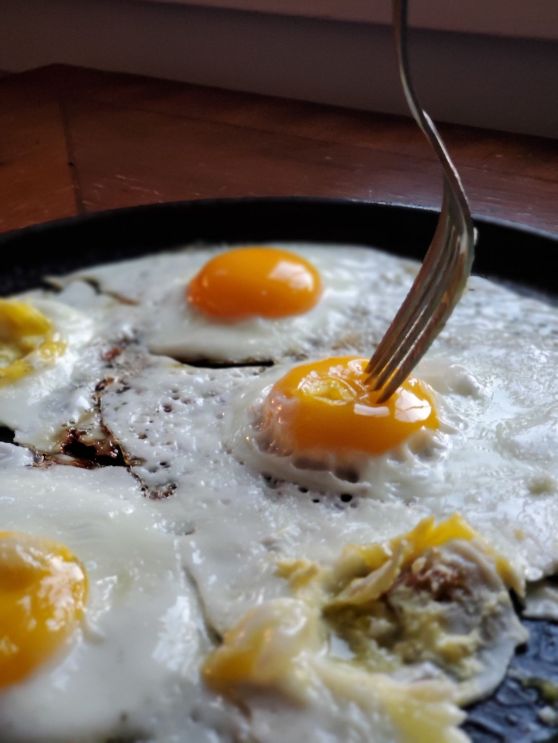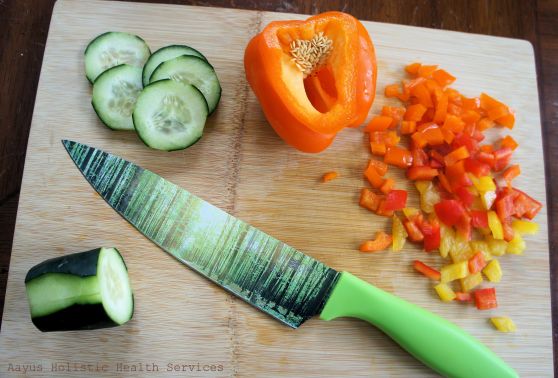
Last year my little family of foodies did a taste test to find out which organic chicken eggs were the best quality- you can read it here. Little Theo was just a speck in my tummy for the last test and isn’t old enough today to indulge with us (sorry little bean!), but I included my husband Matt along with our five year-old daughter Eliana and her questionable egg-describing adjectives again.

We know that of all the options in the grocery store organic eggs are the best choice; an organic certification means the hens must be fed organic feed and have access to the outdoors; animal by-products and GMO crops in feed are prohibited. There can be no traces of synthetic fertilizers, pesticides or herbicides. Forced molting is not allowed, the animals cannot be caged, and the certification requires maintenance of basic animal welfare standards.

Having access to your own home-raised organic chickens is obviously even better, but for those of us who don’t live in an area where it is legal to keep chickens, we need another option. It seems the number of organic brands is growing by the day… which to choose? But don’t fret- we are again taking all of the guesswork out of finding the best eggs and are putting our previous champion Blue Sky Family Farms up against four new contenders.
I purchased all five of the organic products at Woodman’s in Appleton, WI. To stay consistent with what a typical mom’s shopping trip may look like, I used the very scientific method of “I just got done with work and need to grab the first eggs I see because I need to get home as soon as possible and make dinner.” All were fairly similar in appearance, each carton of eggs having slight variance in color, mottling, and size.

When they were cracked open, we found there were some pretty noticeable differences in the color of the yolks though. Full Circle Organics had a slightly thinner shell.

All had similar sell-by dates, were cooked at the same time in a cast iron pan at the same temperature, and were unsalted.

Our observations were as follows:
| BRAND | PRICE | LOCATION | PACKAGE CLAIMS | MATT’S REVIEW | MEGAN’S REVIEW | 5 YEAR OLD’S REVIEW |
| Farmer’s Hen House Organics
(free range) |
$3.99 per dozen | Kalona, IA | “Amish/Mennonite farms, free range, certified humane” | “A little bit of richness. Tasting fat, but not much depth. Clean with no aftertaste.” | “A little big chemically? Good, but not much depth.” | “Tastes like eggs.” |
| Farmer’s Hen House Organics
(pastured) |
$4.89 per dozen | Kalona, IA | “Pastured, 108 sq ft per bird guaranteed, certified humane” | “Definitely more flavor than the first, with the same richness.” | “Rich, better than their free range version. Not complex.” | “Tastes better than the last one.” |
| Pete &
Gerry’s Organics |
$4.99 per dozen | Monroe, NH | “Free range, small family farms, certified humane, vegetarian feed & outdoor forage” | “Rich but less complex flavor compared to the last two. The white is very good.” | “Creamy, but it feels like it should have more flavor given the texture of it.” | “Mushrooms. Mushroom eggs.” |
| Blue Sky Family Farm Organics | $5.79 per dozen | Warsaw, IN | “Pastured, outside 365 days a year, certified humane.” | “Much more full flavor. You experience the taste across the whole of your tongue. The whites have more flavor than the others.” | “Mmm. That’s really good. Rich, deep, savory.” | “Buttery” |
| Full Circle Organics |
$4.19 per dozen
|
Skokie, IL | “Feed does not contain processed animal proteins, free roaming hens” | “Well-rounded flavor. The whites are better than all of the others.” | “Good and rich. But with a weird flavor that sticks to my tongue.” | “Bleeegh. But good.” |

What was particularly interesting to me was that of the same Farmer’s Hen House brand, you could clearly taste and see the difference in the eggs that were from pastured chickens vs the ones from free range chickens. According to the rather broad “free range” regulations the chickens must be allowed to move unrestricted without being confined, and eat a vegetarian diet. Which is odd to me, because chickens are not natural vegetarians. There is no requirement for access to pasture, they must only be allowed gravel or dirt. Pastured chickens on the other hand, must have access to pasture and have the opportunity to eat a more healthful, natural diet for them which includes bugs, worms, and other non-vegetarian things.

So which were the best and which failed the test?
#1- Blue Sky Family Farms (again! our reigning champion!)
#2- Full Circle Organics ( I must note, my husband and I disagreed on this- I felt it was tied with Pete & Gerry’s)
#3- Pete & Gerry’s
#4- Farmer’s Hen House Pastured
#5- Farmer’s Hen House Free Range
So there you go! While I must say they all were good (and much better tasting than the cheap eggs) it was yet another interesting experiment. I’m rather impressed with Blue Sky Family Farm’s consistency and exceptional quality, and they are now officially our best pick out of NINE organic products. The old adage “you get what you pay for” certainly rung true yet again; Blue Sky was well-worth the extra cash, and the cheapest of the five was the only one I would never buy again. Stay tuned and follow my blog and facebook page– I’ll be sourcing more brands to taste test in the future. Which eggs would you like to see tested? Let me know!
Warmly,
Megan Normansell (Kerkhoff), CHC, AADP, CFH
Certified Holistic Practitioner/Holistic Nutrition/Herbalist/Wild Edibles Guide
Follow me on Facebook and Instagram for more recipes and healthy living ideas!
Interested in healing your body naturally?
Get the answers you’ve been searching for, and heal your body for good… naturally. We have successfully helped thousands of people across the country live a healthier life than they ever could have imagined, and specialize in dozens of different health concerns. Curious? Schedule your complimentary consultation with me today! Read the incredible reviews we’ve received over the years here.
http://www.aayushealth.com – megan@aayushealth.com – 920-327-2221
Copyright Megan Normansell 2019 All rights reserved.







 One of my favorite fungi creations- pheasant back bacon. Most meat-eaters will agree it’s delicious, umami, and reminiscent of bacon, and is the only vegan “bacon” that is whole food. It’s also chock full of cancer- fighting polysaccharides.Pheasant back mushrooms are just popping up in Wisconsin so keep your eyes open! Check out
One of my favorite fungi creations- pheasant back bacon. Most meat-eaters will agree it’s delicious, umami, and reminiscent of bacon, and is the only vegan “bacon” that is whole food. It’s also chock full of cancer- fighting polysaccharides.Pheasant back mushrooms are just popping up in Wisconsin so keep your eyes open! Check out  Very easy to make- chop your fresh pheasant back mushroom into small bacon-bit sized pieces and pan fry in either butter or olive oil until golden brown and crispy. (I prefer butter, but if you’re vegan you’ll want to do olive oil.) Season while cooking with Himalayan salt and a sprinkle of smoked paprika and that’s it!
Very easy to make- chop your fresh pheasant back mushroom into small bacon-bit sized pieces and pan fry in either butter or olive oil until golden brown and crispy. (I prefer butter, but if you’re vegan you’ll want to do olive oil.) Season while cooking with Himalayan salt and a sprinkle of smoked paprika and that’s it!





















